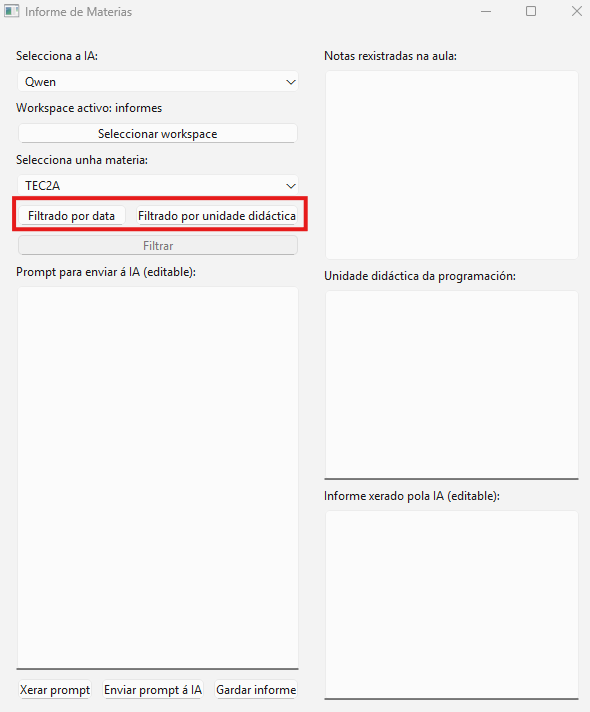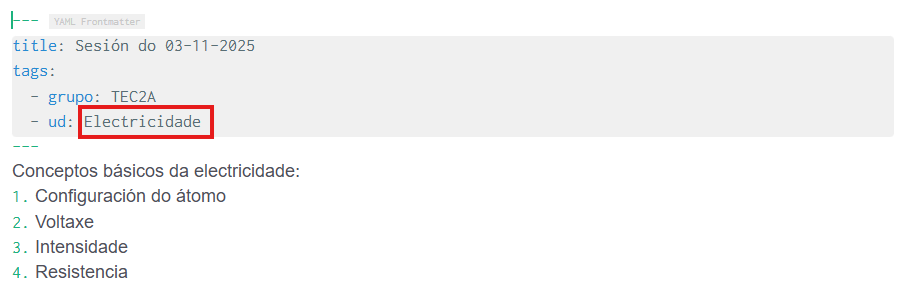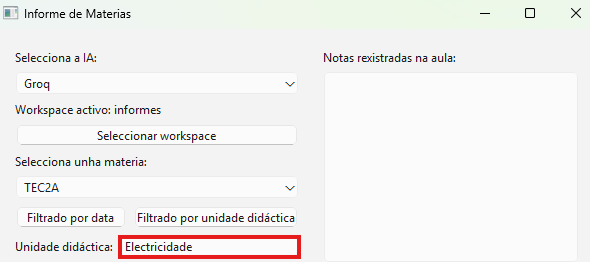With Piztu, you can use a classroom journal. This way, you can record the notes of each session, such as the didactic unit, activities, and contents worked with the group.
To do this, follow these steps:
- Go to the left column.
- Expand the
Subjectsfolder. - Open the subfolder of your group.
- Enter the folder for the corresponding month.
- Finally, open the file with the session date.
The first thing you need to do is fill in the header (YAML code) with the didactic unit you worked on in that session. For example: Electricity.

And then in the body of the note, the specific contents of the didactic unit.

In this way, you can continue to complete the information for all your class sessions.
Report Generation
Open the script Subject Report. The first step is to choose your preferred LLM and then the subject.
From there, you can filter the information to obtain two types of reports:
- By date: You will get a report useful for completing the department’s records book.
- By didactic unit: You will get a report that will help you follow up by didactic unit in Proens.

A. Filtering by Date
If you want to get the information to complete the records book, select the dates from the first to the last day of the month.

The script scans all the notes published in the corresponding subject. By clicking the “Filter” button, the notes will appear in the Registered Notes box.
To use the application’s predefined prompt, click the “Generate Prompt” button.
Finally, click the “Send Prompt to AI” button. The LLM will return the report generated according to the instructions you defined in the prompt and the characteristics of the AI provider. The result could be the following:
The TEC2A didactic unit began on November 3, 2025, and extended until November 28 of the same year. During this period, various contents and activities related to electricity and electrical circuits were worked on, combining theory, practices, and the use of digital tools. On the first day, November 3, basic concepts of electricity such as atomic configuration, voltage, current, and resistance were introduced. On November 4, Ohm's Law was studied and a workshop practice was conducted to measure with a multimeter. On November 5, the calculation of equivalent resistance in series circuits was worked on, using an electronic simulator in the computer lab. On November 6, the calculation of resistances in parallel circuits continued, also with simulator practices. On November 7, mixed circuits were addressed and a practical workshop activity was conducted, consisting of wiring a model house made of foam board. Finally, on November 10, a practice with basic exercises of simple electrical circuits was solved, applying fundamental calculations. This set of activities allowed students to reinforce theoretical knowledge through practice and the use of specialized tools.B. Filtering by Didactic Unit
If you wish to filter the information by didactic unit, you will see that the interface changes slightly. The goal in this case is to compare what was worked on in the classroom with the programming.
To do this, click “Filtering by Didactic Unit”.
Important: When you enter the didactic unit, you must use the same term you used in the note headers.


By clicking the “Filter” button, you will see that all the notes with the term “Electricity” in the header (YAML) appear in the “Registered Classroom Notes” box, in this example.
Additionally, the script queries the Programming folder and the TEC2A subfolder for the didactic unit related to that term. It then retrieves the programming data for that didactic unit and displays it in the “Programmed Didactic Unit” box.

Continue by clicking “Generate the prompt” to obtain a reference prompt that you can personalize.
Then, click “Send Prompt to AI”. The result could be the following:
Comparing the content of the programmed didactic unit for the TEC2A subject on "Electricity" with the registered classroom notes, there is a high degree of achievement of the objectives set in the programming, although with execution concentrated in a shorter period than expected. The programming contemplates 15 sessions between January 27 and February 28, 2025, while the notes reflect activities conducted between November 3 and November 10, 2025, covering the main content in just 6 sessions. The topics addressed in the notes, such as basic electricity concepts (voltage, current, resistance), Ohm's Law, equivalent resistance calculations in series, parallel, and mixed circuits, and workshop and simulator practices, align with the unit description, which includes basic electrical circuits, calculations of electrical magnitudes, and assembly or simulation of circuits. Moreover, the practice of wiring a model house reflects the objective of designing simple installations, meeting the evaluation criteria related to the design and assembly of basic circuits (CA3.1.3, CA3.2.2). However, there is no mention in the notes of content related to the introduction to electronics or the use of digital tools for technical documents (CA5.1.2, CA5.3.3), suggesting that some aspects of the programming may be pending development or not recorded on these dates. In summary, the execution seems effective in fundamental practical and theoretical electricity content but would need to complete aspects related to electronics and digital document elaboration to fully achieve the programmed objectives.The generated report is likely not to adapt directly to the follow-up of each didactic unit of the Proens application. Therefore, you will need to adapt the prompt until you get a report that suits you.
Since you can save these reports as you generate them, by the end of the course you will have a set of appropriate texts to generate the Subject Report, which you also need to reflect in the Proens application. Due to the text size being limited to a number of characters, you might use artificial intelligence to summarize and adapt it to the available space.
In summary, this application is a tool that, on one hand, forces you to enter the tasks and content worked on in each session, creating a classroom journal, and on the other hand, facilitates the editing of tracking reports.
